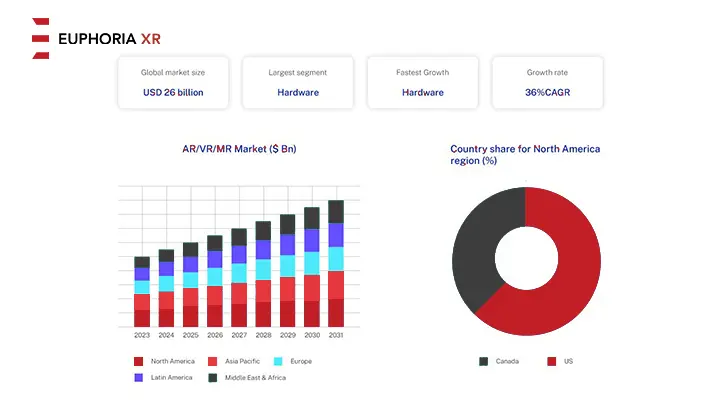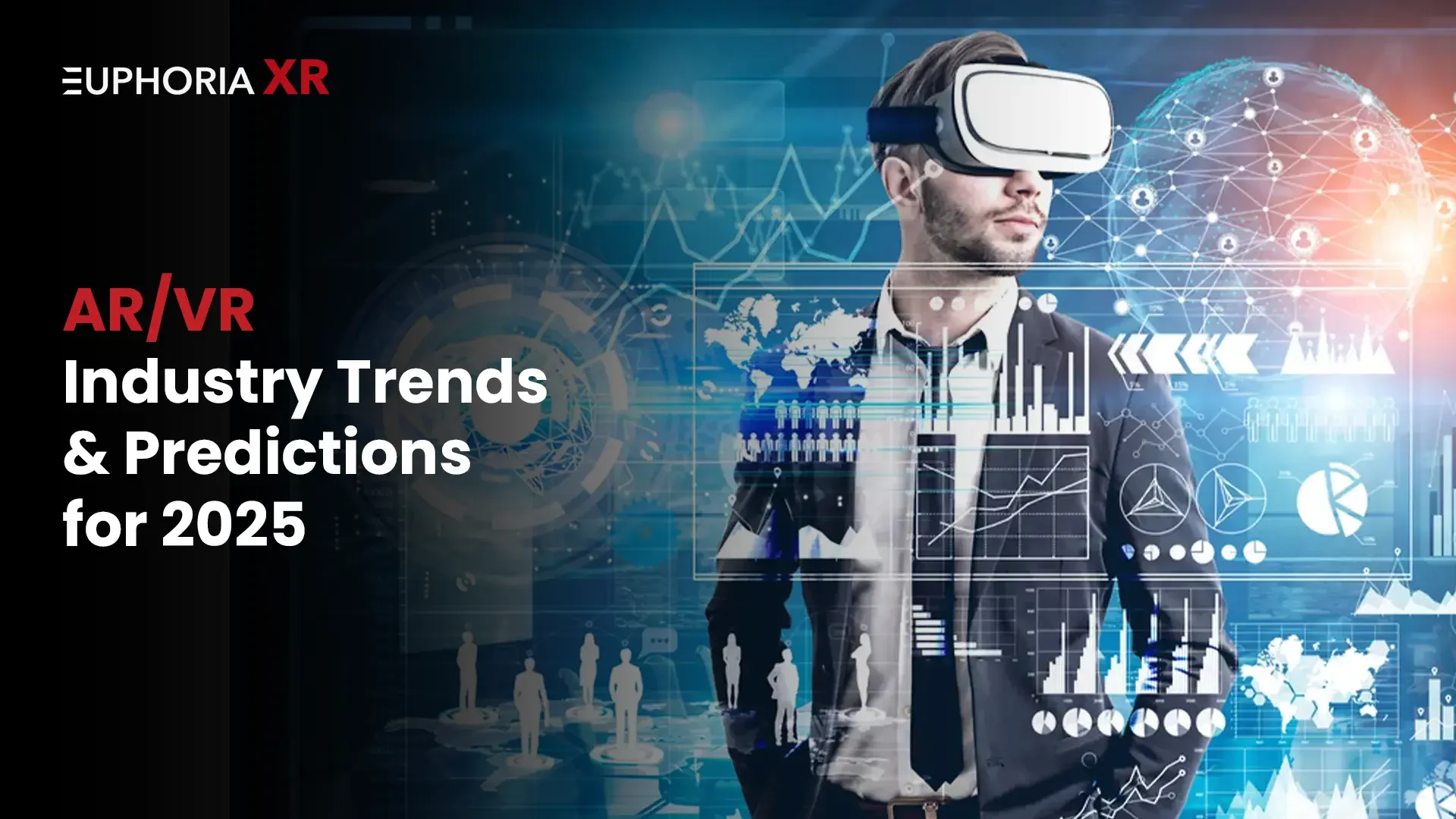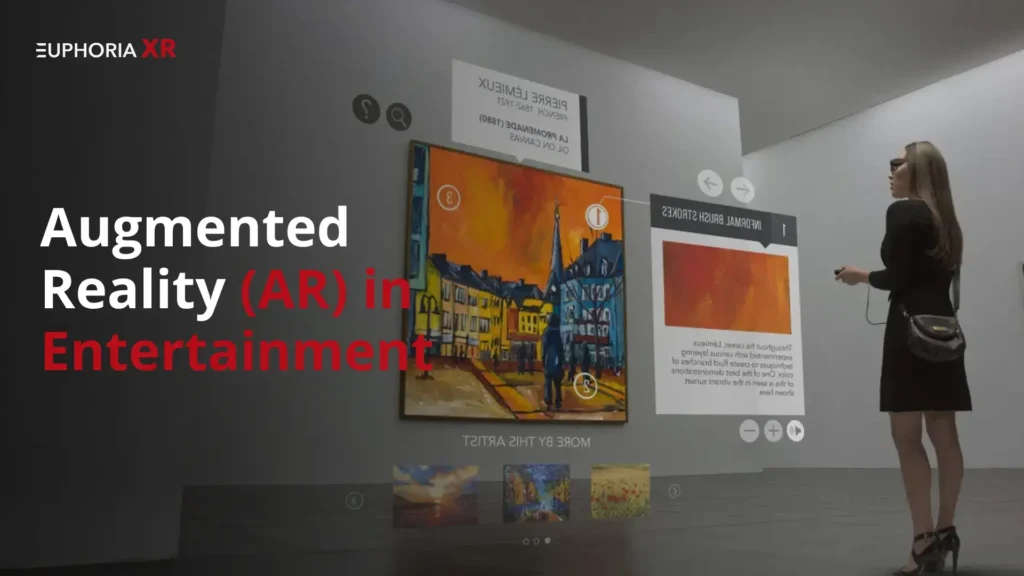Augmented Reality (AR) and Virtual Reality (VR) are rapidly evolving, with 2025 set to bring significant advancements in these immersive technologies. AR enhances the real world with digital elements, while VR creates immersive digital environments.
In recent years, North America has played a major role in investing in the AR/VR market and is anticipated to see continued rapid growth over the next five years. By 2025, the region is expected to capture a significant market share, strongly emphasizing AR and VR technologies to boost operational efficiency.
In this blog, we will explore key AR/VR future predictions and trends that will define the AR and VR landscape in 2025.
Suggested Read: The Role of AR/VR Consulting in Building the Next Generation of Digital Experiences
Market Stats of AR/VR:

The AR/VR market was valued at $22.12 billion in 2024 and is projected to rise to $96.32 billion by 2029. This marks a compound annual growth rate (CAGR) of 34.2% throughout the forecast period from 2024 to 2029.
According to another study, the AR/VR market generated $59.76 billion in revenue in 2024. It is expected to experience a compound annual growth rate (CAGR) of 22.0% from 2025 to 2030, reaching approximately $200.87 billion by 2030.
Augmented reality (AR) and virtual reality (VR) have steadily gained practical applications, and their growth is expected to surge in the coming years. Skyquest reports that the global AR/VR market, valued at $30 billion in 2022, is projected to exceed $520 billion by 2031.
The global AR and VR headset market is projected to be valued at $12.46 billion in 2024 and is expected to grow significantly, reaching approximately $261.92 billion by 2034. This indicates a strong compound annual growth rate (CAGR) of 35.60% throughout the forecast period from 2024 to 2034.
Top AR/VR Industry Trends & Predictions:
1. AI Enhancing AR/VR Experiences
Artificial Intelligence (AI) will be pivotal in improving AR and VR technologies by 2025. AI will make virtual environments more personalized and interactive, transforming applications from gaming to business. As AI continues to evolve, it will enable AR and VR systems to learn from user behavior and preferences, delivering highly customized experiences instantly.
In the gaming world, AR/VR trends for 2025 suggest that NPCs (non-playable characters) will become smarter, adapting to player strategies and making each gaming session unique. Similarly, AI-powered AR tools will offer personalized suggestions and solutions in retail and customer service.
Example: Imagine playing a VR game where the characters and environment adapt to your gameplay style or shopping online with an AR assistant that suggests products based on your previous preferences.
Enhance Your Business with our custom AR/VR Metaverse Development & Consulting Services!
2. AR Revolutionizing the Automotive Industry
The automotive world is embracing AR technology to enhance driving experiences. By 2025, augmented reality will be commonly used in vehicles to provide quick information directly on windshields. Drivers can view navigation instructions, speed limits, and hazard alerts without taking their eyes off the road.
Car manufacturers like Tesla, Audi, and BMW are already exploring AR head-up displays (HUDs), which will make driving safer and more intuitive. This technology will allow drivers to access vital information on road conditions without looking away.
Example: Imagine driving on a busy highway with AR visuals on your windshield. These visuals show lane guidance, navigation routes, and hazard alerts while keeping your hands on the wheel and your eyes forward.
3. The Growth of AR Avatars
By 2025, AR avatars will become integral to digital interactions, allowing users to create lifelike, real-time representations of themselves for business meetings, social interactions, and customer service. These avatars will replicate human movements and expressions, enhancing the personalization of virtual communication.
The future of AR and VR will see these avatars increasingly integrated into platforms, providing a more immersive experience for users in professional and social settings.
Example: Picture attending a virtual conference where your AR avatar mirrors your facial expressions and gestures, providing a more immersive experience. In customer service, imagine interacting with an AR avatar that provides instant support, answering your questions as if they were physically present.
4. WebAR: No Downloads Required
WebAR is set to revolutionize the AR industry by allowing users to access AR experiences directly from their browsers without downloading apps. As AR/VR trends 2025 suggest, this advancement will make AR more accessible to the masses, providing a seamless experience for users and new opportunities for businesses.
Example: Imagine a furniture store that allows you to visualize how different pieces would look in your living room using only your smartphone’s browser. No app download is necessary—just point and place the furniture in your home.
Looking to design a business card that truly stands out? Our WebAR Business Card service helps you create digital cards that spring to life using augmented reality. Impress clients with a unique, interactive experience that engagingly highlights your brand. Just scan the card and watch it turn into an interactive digital experience.
5. 5G Paving the Way for AR/VR Growth
The rollout of 5G networks will be a game-changer for AR and VR, offering faster, more reliable connections. By 2025, the high-speed, low-latency capabilities of 5G will allow for more complex AR and VR applications, enabling seamless multiplayer gaming, remote collaboration, and large-scale AR events.
5G will also make mobile AR and VR experiences more accessible by offloading much of the processing power to the cloud. Users can enjoy high-quality immersive experiences on their mobile devices without high-end hardware.
Example: Imagine playing a VR multiplayer game with friends from around the world with no delays or lag due to the power of 5G. Or imagine attending a virtual concert in AR where everything feels instantaneous and hyper-realistic.
6. Advanced AR/VR Displays: More Immersive, Less Bulky
By 2025, AR and VR headsets will become lighter, more comfortable, and offer higher-resolution displays. Companies are improving these devices’ visual quality and ergonomics to make prolonged use easier and more enjoyable.
We can expect advancements like ultra-high-definition displays, wider fields of view, and more natural eye-tracking, all of which will make AR and VR experience more lifelike and immersive. This will benefit not only gaming and entertainment but also training education, and remote work environments.
Example: Imagine wearing a VR headset that’s so lightweight you forget it’s there, while the visuals are so sharp and detailed that you feel like you’re actually inside the virtual world.
7. XR in Healthcare: A New Era of Treatment and Training
Extended Reality (XR), encompassing AR, VR, and Mixed Reality (MR), is revolutionizing healthcare. By 2025, these technologies will be used extensively in medical training, remote consultations, and surgeries.
VR is already being used to train medical students and surgeons, allowing them to practice complex procedures in a risk-free environment. AR, on the other hand, can assist surgeons by overlaying crucial patient information during operations. Meanwhile, remote consultations via AR and VR will make healthcare more accessible, allowing specialists to diagnose and treat patients from afar.
Example: Picture a surgeon using AR glasses during a procedure. Vital patient information and 3D scans are overlaid directly on their field of view, helping them perform the surgery more precisely.
8. Remote Assistance with AR/VR
AR and VR make remote work more effective by providing quick guidance in various industries. With AR glasses or VR headsets, experts can assist workers remotely, offering step-by-step instructions and real-time feedback without being physically present.
This technology is useful in manufacturing, field services, and engineering, where skilled labor may be in short supply. AR/VR remote assistance allows workers to perform complex tasks with expert guidance, reducing downtime and improving productivity.
Example: A field technician repairing a complex machine can receive instant instructions from an expert hundreds of miles away via AR, reducing repair time and avoiding costly travel delays.
9. AR Navigation: Finding Your Way Has Never Been Easier
AR-based navigation is set to transform how we navigate indoor and outdoor spaces. By overlaying directions and points of interest in the real world, AR navigation will make getting from point A to point B more intuitive.
This technology will be useful in large, complex spaces like airports, malls, or hospitals, where traditional maps can take time to follow. AR navigation will guide users through these spaces with real-time visual cues, making navigation simpler and more efficient.
Example: Imagine walking through a crowded airport with AR navigation guiding you to your gate with visual arrows on your smartphone or smart glasses, ensuring you always stay aware of your location.
Suggested Read: How AR Glasses Are Simplifying Navigation
10. AR/VR in Education: A New Way to Learn
The future of education is immersive, and AR and VR will play a significant role in creating engaging learning environments. By 2025, classrooms will be equipped with AR and VR tools that allow students to explore topics in ways that are impossible with traditional textbooks.
VR will allow students to take virtual field trips, explore historical sites, or perform science experiments in a controlled, simulated environment. AR, meanwhile, will bring subjects to life with interactive 3D models and simulations that make learning more engaging and hands-on.
Example: A history class using VR to take students on a virtual tour of ancient civilizations, where they can walk through ruins and interact with historical artifacts, offering a far richer experience than a traditional textbook.
Final Note!
As discussed in this article, virtual and augmented reality are predicted to greatly influence the corporate sector. However, more than simply understanding AR/VR trends and insights from leading virtual reality companies is required. To strategically and profitably prepare your business for the near future, consult with an AR/VR app development company to integrate these powerful technologies into your operations.















